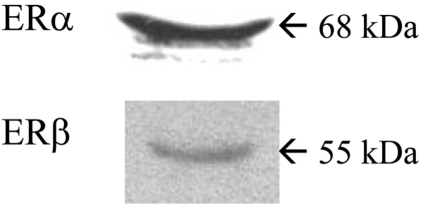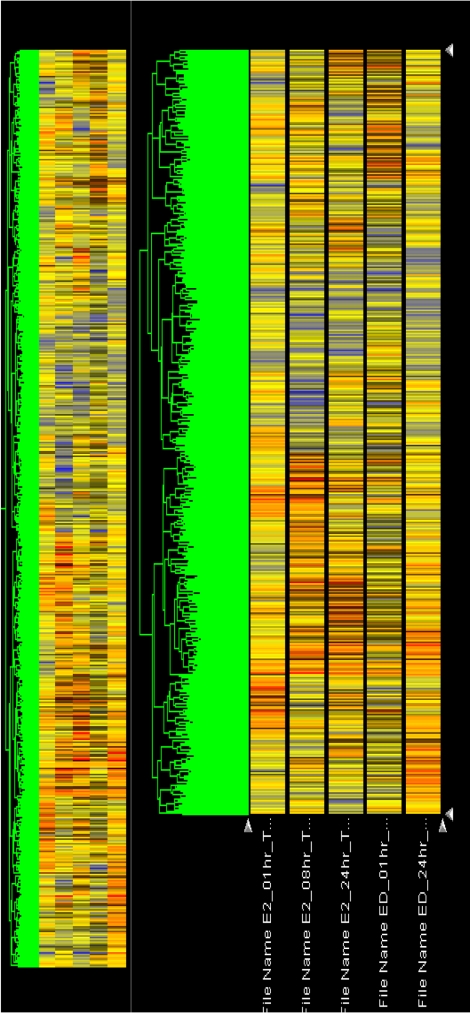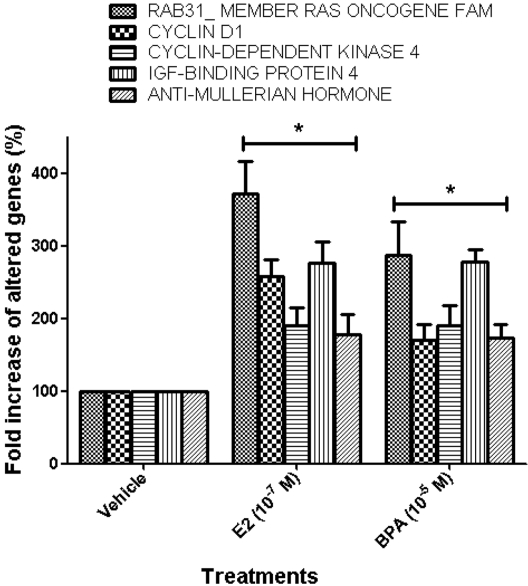Lab Anim Res.
2011 Jun;27(2):99-107. 10.5625/lar.2011.27.2.99.
Gene Alterations of Ovarian Cancer Cells Expressing Estrogen Receptors by Estrogen and Bisphenol A Using Microarray Analysis
- Affiliations
-
- 1Laboratory of Veterinary Biochemistry and Immunology, College of Veterinary Medicine, Chungbuk National University, Cheongju, Republic of Korea. kchoi@cbu.ac.kr
- 2Markey Cancer Center, University of Kentucky, Lexington, USA.
- KMID: 2053658
- DOI: http://doi.org/10.5625/lar.2011.27.2.99
Abstract
- Since endocrine disrupting chemicals (EDCs) may interfere with the endocrine system(s) of our body and have an estrogenicity, we evaluated the effect(s) of bisphenol A (BPA) on the transcriptional levels of altered genes in estrogen receptor (ER)-positive BG-1 ovarian cancer cells by microarray and real-time polymerase-chain reaction. In this study, treatment with 17beta-estradiol (E2) or BPA increased mRNA levels of E2-responsive genes related to apoptosis, cancer and cell cycle, signal transduction and nucleic acid binding etc. In parallel with their microarray data, the mRNA levels of some altered genes including RAB31_MEMBER RAS ONCOGENE FAMILY (U59877), CYCLIN D1 (X59798), CYCLIN-DEPENDENT KINASE 4 (U37022), IGF-BINDING PROTEIN 4 (U20982), and ANTI-MULLERIAN HORMONE (NM_000479) were significantly induced by E2 or BPA in this cell model. These results indicate that BPA in parallel with E2 induced the transcriptional levels of E2-responsive genes in an estrogen receptor (ER)-positive BG-1 cells. In conclusion, these microarray and real-time polymerase-chain reaction results indicate that BPA, a potential weak estrogen, may have estrogenic effect by regulating E2-responsive genes in ER-positive BG-1 cells and BG-1 cells would be the best in vitro model to detect these estrogenic EDCs.
MeSH Terms
-
Anti-Mullerian Hormone
Apoptosis
Benzhydryl Compounds
Cell Cycle
Cyclin D1
Cyclin-Dependent Kinase 4
Endocrine Disruptors
Estrogens
Genes, ras
Humans
Insulin-Like Growth Factor Binding Protein 4
Microarray Analysis
Ovarian Neoplasms
Phenols
Receptors, Estrogen
RNA, Messenger
Signal Transduction
Anti-Mullerian Hormone
Benzhydryl Compounds
Cyclin D1
Cyclin-Dependent Kinase 4
Endocrine Disruptors
Estrogens
Insulin-Like Growth Factor Binding Protein 4
Phenols
RNA, Messenger
Receptors, Estrogen
Figure
Cited by 1 articles
-
Diverse animal models to examine potential role(s) and mechanism of endocrine disrupting chemicals on the tumor progression and prevention: Do they have tumorigenic or anti-tumorigenic property?
Min-Ah Park, Kyung-A Hwang, Kyung-Chul Choi
Lab Anim Res. 2011;27(4):265-273. doi: 10.5625/lar.2011.27.4.265.
Reference
-
1. Choi KC, Jeung EB. The biomarker and endocrine disruptors in mammals. J Reprod Dev. 2003; 49(5):337–345. PMID: 14967909.
Article2. Dang VH, Choi KC, Jeung EB. Tetrabromodiphenyl ether (BDE 47) evokes estrogenicity and calbindin-D9k expression through an estrogen receptor-mediated pathway in the uterus of immature rats. Toxicol Sci. 2007; 97(2):504–511. PMID: 17361017.
Article3. Daston GP, Cook JC, Kavlock RJ. Uncertainties for endocrine disrupters: our view on progress. Toxicol Sci. 2003; 74(2):245–252. PMID: 12730617.
Article4. Borgert CJ, LaKind JS, Witorsch RJ. A critical review of methods for comparing estrogenic activity of endogenous and exogenous chemicals in human milk and infant formula. Environ Health Perspect. 2003; 111(8):1020–1036. PMID: 12826475.
Article5. An BS, Choi KC, Kang SK, Hwang WS, Jeung EB. Novel Calbindin-D(9k) protein as a useful biomarker for environmental estrogenic compounds in the uterus of immature rats. Reprod Toxicol. 2003; 17(3):311–319. PMID: 12759100.
Article6. An BS, Kang SK, Shin JH, Jeung EB. Stimulation of calbindin-D(9k) mRNA expression in the rat uterus by octyl-phenol, nonylphenol and bisphenol. Mol Cell Endocrinol. 2002; 191(2):177–186. PMID: 12062901.
Article7. Crisp TM, Clegg ED, Cooper RL, Wood WP, Anderson DG, Baetcke KP, Hoffmann JL, Morrow MS, Rodier DJ, Schaeffer JE, Touart LW, Zeeman MG, Patel YM. Environmental endocrine disruption: an effects assessment and analysis. Environ Health Perspect. 1998; 106(Suppl 1):11–56. PMID: 9539004.
Article8. Wozniak AL, Bulayeva NN, Watson CS. Xenoestrogens at picomolar to nanomolar concentrations trigger membrane estrogen receptor-alpha-mediated Ca2+ fluxes and prolactin release in GH3/B6 pituitary tumor cells. Environ Health Perspect. 2005; 113(4):431–439. PMID: 15811834.9. Markey CM, Rubin BS, Soto AM, Sonnenschein C. Endocrine disruptors: from Wingspread to environmental developmental biology. J Steroid Biochem Mol Biol. 2002; 83(1-5):235–244. PMID: 12650721.
Article10. Staples CA, Dorn PB, Klecka GM, O'Block ST, Branson DR, Harris LR. Bisphenol A concentrations in receiving waters near US manufacturing and processing facilities. Chemosphere. 2000; 40(5):521–525. PMID: 10665389.
Article11. Steinmetz R, Mitchner NA, Grant A, Allen DL, Bigsby RM, Ben-Jonathan N. The xenoestrogen bisphenol A induces growth, differentiation, and c-fos gene expression in the female reproductive tract. Endocrinology. 1998; 139(6):2741–2747. PMID: 9607780.
Article12. Cupp AS, Skinner MK. Actions of the endocrine disruptor methoxychlor and its estrogenic metabolite on in vitro embryonic rat seminiferous cord formation and perinatal testis growth. Reprod Toxicol. 2001; 15(3):317–326. PMID: 11390175.
Article13. Jorgensen M, Vendelbo B, Skakkebaek NE, Leffers H. Assaying estrogenicity by quantitating the expression levels of endogenous estrogen-regulated genes. Environ Health Perspect. 2000; 108(5):403–412. PMID: 10811566.
Article14. Miller S, Kennedy D, Thomson J, Han F, Smith R, Ing N, Piedrahita J, Busbee D. A rapid and sensitive reporter gene that uses green fluorescent protein expression to detect chemicals with estrogenic activity. Toxicol Sci. 2000; 55(1):69–77. PMID: 10788561.
Article15. Shelby MD, Newbold RR, Tully DB, Chae K, Davis VL. Assessing environmental chemicals for estrogenicity using a combination of in vitro and in vivo assays. Environ Health Perspect. 1996; 104(12):1296–1300. PMID: 9118870.
Article16. Quesada I, Fuentes E, Viso-Leon MC, Soria B, Ripoll C, Nadal A. Low doses of the endocrine disruptor bisphenol-A and the native hormone 17-beta-estradiol rapidly activate transcription factor CREB. FASEB J. 2002; 16(12):1671–1673. PMID: 12207000.17. Ren L, Marquardt MA, Lech JJ. Estrogenic effects of nonylphenol on pS2, ER and MUC1 gene expression in human breast cancer cells-MCF-7. Chem Biol Interact. 1997; 104(1):55–64. PMID: 9158695.
Article18. Witorsch RJ. Endocrine disruptors: can biological effects and environmental risks be predicted. Regul Toxicol Pharmacol. 2002; 36(1):118–130. PMID: 12383724.
Article19. Hong E, Choi KC, Jeung EB. Maternal-fetal transfer of endocrine disruptors in the induction of Calbindin-D9k mRNA and protein during pregnancy in rat model. Mol Cell Endocrinol. 2003; 212:63–72. PMID: 14654251.
Article20. Geisinger KR, Kute TE, Pettenati MJ, Welander CE, Dennard Y, Collins LA, Berens ME. Characterization of a human ovarian carcinoma cell line with estrogen and progesterone receptors. Cancer. 1989; 63(2):280–288. PMID: 2910432.
Article21. Tabb MM, Blumberg B. New modes of action for endocrine disrupting chemicals. Mol Endocrinol. 2006; 20(3):475–482. PMID: 16037129.22. McCormick SD, O'Dea MF, Moeckel AM, Lerner DT, Bjornsson BT. Endocrine disruption of parr-smolt transformation and seawater tolerance of Atlantic salmon by 4-nonylphenol and 17beta-estradiol. Gen Comp Endocrinol. 2005; 142(3):280–288. PMID: 15935154.23. Fisher JS. Environmental anti-androgens and male reproductive health: focus on phthalates and testicular dysgenesis syndrome. Reproduction. 2004; 127(3):305–315. PMID: 15016950.
Article24. McVey MJ, Cooke GM, Curran IH. Increased serum and testicular androgen levels in F1 rats with lifetime exposure to soy isoflavones. Reprod Toxicol. 2004; 18(5):677–685. PMID: 15219630.
Article25. Tyler CR, Jobling S, Sumpter JP. Endocrine disruption in wildlife: a critical review of the evidence. Crit Rev Toxicol. 1998; 28(4):319–361. PMID: 9711432.
Article26. Anway MD, Cupp AS, Uzumcu M, Skinner MK. Epigenetic transgenerational actions of endocrine disruptors and male fertility. Science. 2005; 308(5727):1466–1469. PMID: 15933200.
Article27. Younglai EV, Holloway AC, Foster WG. Environmental and occupational factors affecting fertility and IVF success. Hum Reprod Update. 2005; 11(1):43–57. PMID: 15601728.
Article28. Younglai EV, Holloway AC, Lim GE, Foster WG. Synergistic effects between FSH and 1,1-dichloro-2,2-bis(P-chlorophenyl) ethylene (P,P'-DDE) on human granulosa cell aromatase activity. Hum Reprod. 2004; 19(5):1089–1093. PMID: 15070871.29. Anway MD, Skinner MK. Epigenetic transgenerational actions of endocrine disruptors. Endocrinology. 2006; 147(6 Suppl):S43–S49. PMID: 16690803.
Article30. An BS, Choi KC, Kang SK, Lee GS, Hong EJ, Hwang WS, Jeung EB. Mouse calbindin-D(9k) gene expression in the uterus during late pregnancy and lactation. Mol Cell Endocrinol. 2003; 205(1-2):79–88. PMID: 12890569.
Article31. Lee GS, Kim HJ, Jung YW, Choi KC, Jeung EB. Estrogen receptor alpha pathway is involved in the regulation of Calbindin-D9k in the uterus of immature rats. Toxicol Sci. 2005; 84(2):270–277. PMID: 15635152.32. Hong EJ, Ji YK, Choi KC, Manabe N, Jeung EB. Conflict of estrogenic activity by various phthalates between in vitro and in vivo models related to the expression of Calbindin-D9k. J Reprod Dev. 2005; 51(2):253–263. PMID: 15883486.
Article33. Hong EJ, Choi KC, Jeung EB. Induction of calbindin-D9k messenger RNA and protein by maternal exposure to alkylphenols during late pregnancy in maternal and neonatal uteri of rats. Biol Reprod. 2004; 71(2):669–675. PMID: 15070829.34. Hong EJ, Choi KC, Jeung EB. Maternal exposure to bisphenol a during late pregnancy resulted in an increase of Calbindin-D9k mRNA and protein in maternal and postnatal rat uteri. J Reprod Dev. 2005; 51(4):499–508. PMID: 15947454.
Article35. Hong EJ, Choi KC, Jung YW, Leung PC, Jeung EB. Transfer of maternally injected endocrine disruptors through breast milk during lactation induces neonatal Calbindin-D9k in the rat model. Reprod Toxicol. 2004; 18(5):661–668. PMID: 15219628.
Article36. Hong EJ, Choi KC, Jeung EB. Maternal-fetal transfer of endocrine disruptors in the induction of Calbindin-D9k mRNA and protein during pregnancy in rat model. Mol Cell Endocrinol. 2003; 212:63–72. PMID: 14654251.
Article37. Lee GS, Choi KC, Kim HJ, Jeung EB. Effect of genistein as a selective estrogen receptor beta agonist on the expression of Calbindin-D9k in the uterus of immature rats. Toxicol Sci. 2004; 82(2):451–457. PMID: 15456916.
Article38. Schrader TJ, Cooke GM. Effects of Aroclors and individual PCB congeners on activation of the human androgen receptor in vitro. Reprod Toxicol. 2003; 17(1):15–23. PMID: 12507654.
Article39. Spearow JL, Barkley M. Reassessment of models used to test xenobiotics for oestrogenic potency is overdue. Hum Reprod. 2001; 16(5):1027–1029. PMID: 11331655.
Article40. Park SH, Kim KY, An BS, Choi JH, Jeung EB, Leung PC, Choi KC. Cell growth of ovarian cancer cells is stimulated by xenoestrogens through an estrogen-dependent pathway, but their stimulation of cell growth appears not to be involved in the activation of the mitogen-activated protein kinases ERK-1 and p38. J Reprod Dev. 2009; 55(1):23–29. PMID: 18854640.
Article
- Full Text Links
- Actions
-
Cited
- CITED
-
- Close
- Share
- Similar articles
-
- Effects of estrogen receptor and estrogen on the chromatin structure in estrogen receptor stable transfectants
- Additive Estrogenic Activities of the Binary Mixtures of Four Estrogenic Chemicals in Recombinant Yeast Expressing Human Estrogen Receptor
- Immunohistochemical studies on the rate of positive reaction of estrogen receptors and progesterone receptors in the breast diseases
- Immunocytochemical analysis for estrogen receptors in the patients with thyroid disease
- Bone Morphogenetic Protein-2 Desensitizes MC3T3-E1 Osteoblastic Cells to Estrogen Through Transcriptional Downregulation of Estrogen Receptor 1




